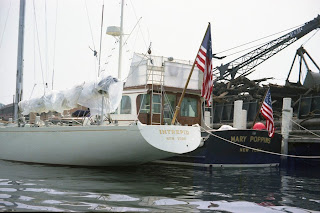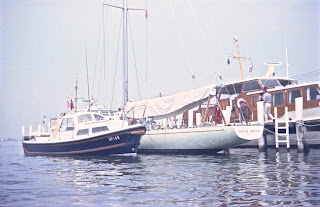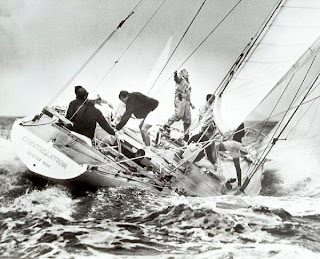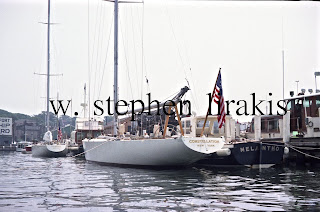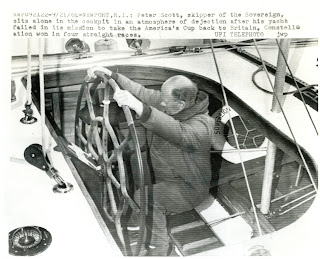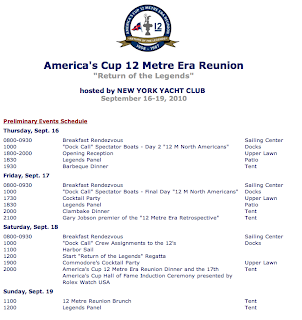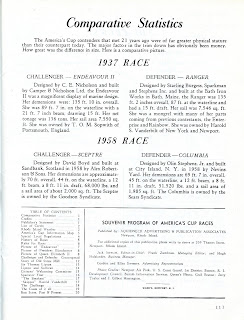http://www.livestream.com/34thac
http://voices.washingtonpost.com/plum-line/2010/05/how_liebermans_citizen-strippi.html
Category: america’s cup
TRIM TABS AND BUSTLES 1967
Remember that 1958 saw the first 12 meters built since before world war II. Now the America’s Cup is into it’s fourth event since 1937.
Tank testing has shown that the concept of a trim tab with a rudder much further aft would be a breakthrough. Other boats would add bustle, ie. additional displacement aft but S&S who carried out design modifications on ” Columbia” could not reveal what they had done in the design for “Intrepid”.
“Columbia” was capably steered by Bill Ficker, who kept her in the game until the end.
“Intrepid” would loose only once during the entire summer. She could outmanoeuvre the competition with ease. As far as I could tell most of the starts I saw, she would “sandbag” and still get to the weather mark first. It should be noted the Bus Mosbacher was helmsman and probably the finest of his generation.
“Dame Pattie” designed by Warrick Hood, might have been a worthy challenger had the defender been more like “Constellation”
With each defense came new ideas. As new information was developed, the problem was how to interpret properly that new information.
more 1964
The color photos are courtesy of Dick Enersen, crew of “Constellation” in 1964. Each photo is a story in itself. Dick looking very young indeed under the Connie shed sign. The final photo of Eric Ritter the helmsman, who stepped aside in the interest of the boat, greeting Harry Morgan, head of the selection committee bringing the good news that “Constellation” has been selected to defend.
The black and white photo I believe was taken on a day when most of the other 12 meters lost their masts.
I would like to hear from more of the crews out there. Thankyou Dick.
Another look at the 1964 summer
Looking back from today’s perspective makes the gear and sails in particular look primitive. I is hard to imagine that the 12 meters of the era were the cutting edge of sailing. Look at the boom vang in the earlier post. The mainsheet winch, practically the smallest winch on the boat for the largest sail; and four parts. Just think what that must have been like at the leeward mark.
Hanks were still used on headsails. I believe an argument could be mounted defending hanks, tactically, look at the photo of the bow of “Constellation”, Buddy Bombard is standing in the forward hatch, a jib would be stopped and hoisted through this hatch; sheets attached, at a leeward mark, a boat could carry the spinnaker right to the mark, breaking out the genoa at the last possible moment.
Wooden boats built to lloyd’s scantlings. Designers and builders did what they could to save weight. I would not be until 1974 when aluminum would be allowed and 1986 when the first fiberglass 12 meters came into being.
Weather, was not much beyond the farmer’s almanac. Statics accumulated over time were the only analysis available.
Ash blocks with bronze bearings were still common. Lines were still large and heavy. Change came slowly
America’s Cup 1964
With each new challenge the design race increased. “Constellation” the newest Sparkman&Stephens design was only second best entering the August trails. “American Eagle” the Bill Luders design and build, was up 21 and zero, appearing unbeatable and in the difficult position of not having lost a race; not knowing what if anything to change.
Eric Ridder stepped aside as skipper of “Connie”being replaced by Bob Bavier. Along with a few other changes and she went on to be selected to defend. Leaving Bill Cox the skipper of “American Eagle” stunned.
The American trials were the highlight of the summer, the English challenger “Sovereign” was hopelessly outclassed.
Olin Stephens, I believed, liked to make small incremental changes, As the season of 1967 would show; “Constellation” exhibited some of the genes that would become “Intrepid”.
The energy and enthusiasm ratcheted up with each challenge. The world was emerging from World War II, coupled with that was the easing of Taxes on the rich. America was truly on top of the world; and feeling that way.
There are more stories connected with the summer of 1964 and this challenge deserves more time.
1962 America’s Cup
America’s Cup 1958
It is important to put 1958 in historical context. This was the first challenge for the America’s Cup since 1937; when it was raced for in “J” class yachts, around 130 feet in length. Life was different, a depression, a world war, taxes were higher than today, for the wealthy.
Olin Stephens had designed “Vim” for Harold Vanderbilt in 1939 (sail # 15) “Columbia” (sail # 16) built in 1958 both at Nevins’ yard in City Island. “Vim” pressed “Columbia” and made the selection committee’s job a hard one.
12 METER ERA RE-UNION
The 12 meter era of the America’s cup is announced
Sceptre, K 17 the British challenge 1958
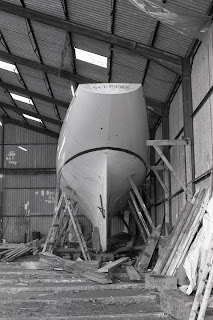 Sceptre, sail number k 17, was the Royal Yacht Squadron’s challenger, built in Scotland, designed by David Boyd. launched in April 0f 1958.
Sceptre, sail number k 17, was the Royal Yacht Squadron’s challenger, built in Scotland, designed by David Boyd. launched in April 0f 1958.


